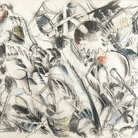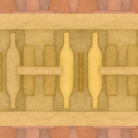Calculating Empires: A Genealogy of Technology and Power, 1500-2025

Kate Crawford e Vladan Joler, Estratti dalla mappa Calculating Empires | Courtesy Osservatorio Prada
Dal 23 November 2023 al 29 January 2024
Milano
Luogo: Osservatorio Prada
Indirizzo: Galleria Vittorio Emanuele II
Sito ufficiale: http://fondazioneprada.org
Fondazione Prada presenta la mostra “Calculating Empires: A Genealogy of Technology and Power, 1500-2025” di Kate Crawford e Vladan Joler dal 23 novembre 2023 al 29 gennaio 2024, nella sede di Osservatorio in Galleria Vittorio Emanuele II a Milano.
Osservatorio è lo spazio di Fondazione Prada dedicato alla sperimentazione dei linguaggi visivi e alla ricerca sulle possibili intersezioni e collisioni tra la tecnologia e le varie espressioni culturali. È una piattaforma di libero pensiero aperta alla riflessione sui differenti linguaggi artistici e dei media e sul loro impatto in un contesto politico e sociale in continua evoluzione.
Ideata dai ricercatori-artisti Kate Crawford e Vladan Joler, “Calculating Empires” mappa il nostro presente tecnologico, illustrando come il potere e la tecnologia siano intrecciati a partire dal 1500. Unendo ricerca e design, scienza e arte, Joler e Crawford sviluppano una nuova chiave di lettura per comprendere il panorama attuale dell’intelligenza artificiale interrogandosi su come siamo arrivati fino a qui e su dove potremmo essere diretti. Questo progetto apre la mente a nuove prospettive e invita i visitatori a provare il concetto di “lunga durata” attraverso una visualizzazione del tempo, della politica e della tecnologia.
Come afferma Joler: “Questo è l’anno in cui l’intelligenza artificiale generativa ha inondato la cultura globale e ha dominato l’attenzione pubblica. Milioni di persone hanno cambiato il loro modo di fare ricerche online, di scrivere e di sviluppare immagini. Tuttavia questi sistemi hanno già dimostrato la loro capacità di concentrare il potere, produrre ‘allucinazioni collettive’ e disinformazione su larga scala, mettendo in discussione la percezione di una realtà condivisa. L’IA generativa ha inoltre un impatto significativo sulle nostre ecologie, necessitando di immense quantità di energia, acqua e minerali”. Come precisa Crawford: “Tutte queste forme di impatto globale, da quelle di ordine politico a quelle materiali, si sono sviluppate nel corso di alcuni secoli. Sono però nascoste dalla cultura del segreto industriale e delle infrastrutture tecniche, dalle questioni complesse legate al colonialismo, dalle filiere globali di produzione e distribuzione, dalla scarsa trasparenza dei contratti di lavoro, dalla mancanza di regolamentazione e dalla storia stessa. ‘Calculating Empires’ riflette su come osservare e analizzare questi sistemi nel corso del tempo”.
L’elemento centrale della mostra è la Calculating Empires Map Room, un ambiente buio in cui i visitatori saranno immersi come se entrassero in una vera e propria scatola nera. L’opera, presentata al pubblico per la prima volta, è un dittico di mappe: una tratta di temi legati alla comunicazione e alla computazione, l’altra esplora elementi di controllo e classificazione. Questa stanza delle mappe è un’intensa esperienza fisica, un incontro vertiginoso con cinquecento anni di storia. È progettata per misurare gli imperi e per esplorare come questi stessi imperi abbiano misurato la storia.
Calculating Empires è un codice della tecnologia e del potere che mostra come l’eco degli imperi dei secoli passati risuoni nelle aziende tecnologiche di oggi. Questa dettagliata narrazione visiva si estende per oltre ventiquattro metri e ha richiesto quasi quattro anni di lavoro. Con migliaia di disegni e di testi realizzati singolarmente, illustra forme di comunicazione, classificazione, computazione e controllo che attraversano secoli di conflitti, confini e colonizzazioni.
Calculating Empires propone una modalità di lettura più lenta, collocando innovativi dispositivi tecnologici e scoperte in un contesto storio e politico molto più ampio. Questo approccio predilige la complessità e una lettura attraverso la cronologia e gli eventi, raggruppando fenomeni diversi al fine di individuare modelli che si ripetono nel lungo periodo. Una delle mappe rivela la molteplicità dei nostri dispositivi di comunicazione, delle interfacce, delle infrastrutture, delle pratiche di raccolta e utilizzo dei dati, delle architetture computazionali e di hardware. L’altra mappa esplora come queste tecnologie si intrecciano nelle pratiche sociali di classificazione e controllo: dalle carceri alla sorveglianza, dal tempo all’istruzione, dal colonialismo e lo sviluppo economico alla pluralità dei sistemi militari. Non a caso le mappe di Calculating Empires partono dal 1500, un secolo in cui si svilupparono due enormi movimenti politici, sociali e culturali che si sarebbero espansi per altre centinaia di anni. Da un lato, si aprono nuove rotte marittime e commerciali che estendono la colonizzazione e l’assoggettamento delle popolazioni indigene. Dall’altro, la tecnica tipografica di Gutenberg diventa uno strumento di profondo cambiamento culturale che porta alla riorganizzazione del potere delle reti di informazione. Oggi ci troviamo in un altro momento di trasformazione globale, caratterizzato da guerre, intelligenza artificiale generativa, crisi climatica e una profonda incertezza che anima il dibattito pubblico. Calculating Empires si ispira a progetti su larga scala come Atlas di Aby Warburg, sviluppato negli anni Venti per raccogliere e collegare schemi, idee e motivi tratti da migliaia di anni di cultura umana, e la mostra “Mathematica” degli Eames all’inizio degli anni Sessanta che affrontava la complessa storia della matematica attraverso l’arte, il design e l’educazione. Con modalità diverse Warburg ed Eames hanno sviluppato linguaggi di rappresentazione visiva su larga scala per trasmettere idee complesse e narrazioni storiche. Queste configurazioni assumevano la valenza di interventi politici che approfondivano le modalità con cui percepiamo e interpretiamo il passato. In continuità con questa tradizione, Calculating Empires esamina cinquecento anni di storia per elaborare riflessioni politiche sui pericoli della centralizzazione del potere e il controllo sulla soggettività e l’autonomia individuali.
Per contestualizzare questo nuovo lavoro, il pubblico si troverà inizialmente davanti ad Anatomy of an AI System di Joler e Crawford, parte della collezione permanente del MoMA di New York e del V&A di Londra. Anatomy of an AI System è un diagramma esploso focalizzato sul caso di studio della voce assistita di Amazon Echo, un dispositivo che ricorre all’intelligenza artificiale. Questa mappa anatomica mostra i tre principali processi estrattivi necessari al funzionamento di qualsiasi sistema di AI su larga scala: risorse materiali, manodopera umana e dati. Esistono profonde interconnessioni tra la letterale opera di estrazione delle risorse della Terra e l’estrapolazione dei dati della comunicazione umana, della cultura e delle connessioni. Se Calculating Empires parla di tempo, Anatomy of an AI System si interessa allo spazio.
Se il pubblico legge la mappa da sinistra a destra, la storia inizia con la Terra e lo sfruttamento dei processi geologici nel tempo profondo e termina con la degradazione e la dispersione dei rifiuti elettronici tossici nel terreno. Al contrario, se il pubblico la legge dall’alto verso il basso, la storia inizia e finisce con un essere umano. In cima si trova l’utente umano che parla con l’Echo che, contemporaneamente, fornisce ad Amazon dati preziosi per l’addestramento alla risposta verbale che l’azienda usa per affinare i suoi sistemi di intelligenza artificiale ad attivazione vocale. In fondo alla mappa si racconta un’altra storia umana, quella della conoscenza e della cultura dell’uomo che oggi viene estratta per addestrare e ottimizzare i sistemi di IA.
L’Anatomy Room esamina le centinaia di catene di approvvigionamento di minerali, energia e manodopera umana che hanno dato inizio all’ascesa dell’intelligenza artificiale. Lo spazio include un Echo dissezionato, una collezione di tutti i singoli minerali che vengono estratti per produrlo e un’esposizione di brevetti che illustrano la visione aziendale di Amazon sull’IA. I brevetti svelano un piano per utilizzare l’IA al fine di sorvegliare il lavoro degli operai, oltre alle attività delle persone del quartiere mentre camminano per strada e le presunte emozioni e lo stato di salute di ogni singolo utente Echo.
Il progetto comprende anche un’opera realizzata dall’artista Simon Denny nel 2019, ispirata direttamente da Anatomy of an AI System. L’opera, dal titolo Amazon worker cage patent drawing as virtual King Island Brown Thornbill cage (US 9,280,157 B2: “System and method for transporting personnel within an active workspace”, 2016), è una riproduzione di un brevetto Amazon di una gabbia concepita per ospitare operai all’interno dei magazzini logistici.
La mostra si conclude con una stanza delle meraviglie che presenta una collezione eclettica di libri, dispositivi ed ephemera dal 1500 al 2023 e un luogo dedicato alla riflessione. Lo spazio riunisce esempi fisici degli oggetti e dei libri raffigurati nella sala delle mappe, oggetti che esplorano le relazioni tra classificazione, calcolo e controllo, dalle prime macchine per il calcolo ai chip semiconduttori.
Lo spazio finale è una piccola biblioteca che invita i visitatori a leggere, reimmaginare e scrivere commenti, revisioni e complicazioni della storia all’interno di volumi fatti a mano. Qualsiasi mostra che attraversi i secoli sarà necessariamente incompleta, imparziale e soggettiva, non potrà mai essere conclusa, perciò queste mappe sono state pensate per essere pronte ad accogliere stimoli esterni ed evolversi nel tempo.
La mostra “Calculating Empires: A Genealogy of Technology and Power, 1500-2025” è accompagnata da una pubblicazione illustrata della collana Quaderni, pubblicata da Fondazione Prada, che include un saggio di Kate Crawford.
Kate Crawford è una delle massime ricercatrici internazionali sull’intelligenza artificiale. È professore di ricerca presso l’USC Annenberg di Los Angeles, Senior Principal Reasearcher presso l’MSR di New York ed è stata Visiting Chair for AI and Justice all’École Normale Supérieure di Parigi. Il suo ultimo libro, Atlas of AI, ha vinto il Sally Hacker Prize, l’ASST&T Book Award ed è stato nominato uno dei migliori libri dell’anno dal Financial Times e dal New Scientist. Crawford ha inoltre creato installazioni artistiche e indagini visive che sono state esposte in più di cento mostre in tutto il mondo. Il suo progetto Anatomy of an AI System, sviluppato con Vladan Joler, fa parte della collezione permanente del MoMA di New York e del V&A di Londra, ed è stato premiato con il Design of the Year Award nel 2019, oltre a essere incluso nel Design of the Decades del Design Museum di Londra. La sua collaborazione artistica e di ricerca con Trevor Paglen, Training Humans, è stata presentata in anteprima all’Osservatorio di Fondazione Prada e ha vinto il Premio Ayrton della British Society for the History of Science. Crawford attualmente dirige il Knowing Machines Project, una collaborazione di ricerca transatlantica che coinvolge scienziati, artisti e studiosi di diritto che investigano i dati di addestramento dei sistemi AI. Nel 2023 Crawford è stata inserita nella lista TIME100 come una delle persone più influenti nel campo dell’intelligenza artificiale.
Vladan Joler è un accademico, ricercatore e artista. Il suo lavoro fonde indagini sui dati, contro cartografia, giornalismo investigativo, scrittura, visualizzazione dei dati, design critico e numerose altre discipline. È cofondatore della Fondazione SHARE e professore presso il dipartimento New Media dell’Università di Novi Sad. Nel 2018, in collaborazione con Kate Crawford, ha pubblicato Anatomy of an AI System, una mappa su larga scala e un saggio sulla manodopera, i dati e le risorse planetarie necessarie per produrre e far funzionare un dispositivo Amazon Echo. Uno studio precedente, intitolato Facebook Algorithmic Factory, comprendeva indagini forensi approfondite e una mappatura visiva dei processi algoritmici e delle forme di sfruttamento dietro al più grande social network. Il lavoro di Vladan Joler è presente nelle collezioni permanenti del Museum of Modern Art (MoMA) di New York, del Victoria and Albert Museum e del Design Museum di Londra, oltre all’esposizione permanente dell’Ars Electronica Center. Il suo lavoro è stato esposto in più di cento mostre di istituzioni e musei internazionali come: MoMA, ZKM, XXII Triennale di Milano, HKW, Biennale di Vienna, V&A, Transmediale, Ars Electronica, Biennale WRO, Design Society Shenzhen, Hyundai Motorstudio Beijing, MONA, Glassroom, La Gaîté Lyrique, il Consiglio d’Europa a Strasburgo e il Parlamento Europeo a Bruxelles.
Osservatorio è lo spazio di Fondazione Prada dedicato alla sperimentazione dei linguaggi visivi e alla ricerca sulle possibili intersezioni e collisioni tra la tecnologia e le varie espressioni culturali. È una piattaforma di libero pensiero aperta alla riflessione sui differenti linguaggi artistici e dei media e sul loro impatto in un contesto politico e sociale in continua evoluzione.
Ideata dai ricercatori-artisti Kate Crawford e Vladan Joler, “Calculating Empires” mappa il nostro presente tecnologico, illustrando come il potere e la tecnologia siano intrecciati a partire dal 1500. Unendo ricerca e design, scienza e arte, Joler e Crawford sviluppano una nuova chiave di lettura per comprendere il panorama attuale dell’intelligenza artificiale interrogandosi su come siamo arrivati fino a qui e su dove potremmo essere diretti. Questo progetto apre la mente a nuove prospettive e invita i visitatori a provare il concetto di “lunga durata” attraverso una visualizzazione del tempo, della politica e della tecnologia.
Come afferma Joler: “Questo è l’anno in cui l’intelligenza artificiale generativa ha inondato la cultura globale e ha dominato l’attenzione pubblica. Milioni di persone hanno cambiato il loro modo di fare ricerche online, di scrivere e di sviluppare immagini. Tuttavia questi sistemi hanno già dimostrato la loro capacità di concentrare il potere, produrre ‘allucinazioni collettive’ e disinformazione su larga scala, mettendo in discussione la percezione di una realtà condivisa. L’IA generativa ha inoltre un impatto significativo sulle nostre ecologie, necessitando di immense quantità di energia, acqua e minerali”. Come precisa Crawford: “Tutte queste forme di impatto globale, da quelle di ordine politico a quelle materiali, si sono sviluppate nel corso di alcuni secoli. Sono però nascoste dalla cultura del segreto industriale e delle infrastrutture tecniche, dalle questioni complesse legate al colonialismo, dalle filiere globali di produzione e distribuzione, dalla scarsa trasparenza dei contratti di lavoro, dalla mancanza di regolamentazione e dalla storia stessa. ‘Calculating Empires’ riflette su come osservare e analizzare questi sistemi nel corso del tempo”.
L’elemento centrale della mostra è la Calculating Empires Map Room, un ambiente buio in cui i visitatori saranno immersi come se entrassero in una vera e propria scatola nera. L’opera, presentata al pubblico per la prima volta, è un dittico di mappe: una tratta di temi legati alla comunicazione e alla computazione, l’altra esplora elementi di controllo e classificazione. Questa stanza delle mappe è un’intensa esperienza fisica, un incontro vertiginoso con cinquecento anni di storia. È progettata per misurare gli imperi e per esplorare come questi stessi imperi abbiano misurato la storia.
Calculating Empires è un codice della tecnologia e del potere che mostra come l’eco degli imperi dei secoli passati risuoni nelle aziende tecnologiche di oggi. Questa dettagliata narrazione visiva si estende per oltre ventiquattro metri e ha richiesto quasi quattro anni di lavoro. Con migliaia di disegni e di testi realizzati singolarmente, illustra forme di comunicazione, classificazione, computazione e controllo che attraversano secoli di conflitti, confini e colonizzazioni.
Calculating Empires propone una modalità di lettura più lenta, collocando innovativi dispositivi tecnologici e scoperte in un contesto storio e politico molto più ampio. Questo approccio predilige la complessità e una lettura attraverso la cronologia e gli eventi, raggruppando fenomeni diversi al fine di individuare modelli che si ripetono nel lungo periodo. Una delle mappe rivela la molteplicità dei nostri dispositivi di comunicazione, delle interfacce, delle infrastrutture, delle pratiche di raccolta e utilizzo dei dati, delle architetture computazionali e di hardware. L’altra mappa esplora come queste tecnologie si intrecciano nelle pratiche sociali di classificazione e controllo: dalle carceri alla sorveglianza, dal tempo all’istruzione, dal colonialismo e lo sviluppo economico alla pluralità dei sistemi militari. Non a caso le mappe di Calculating Empires partono dal 1500, un secolo in cui si svilupparono due enormi movimenti politici, sociali e culturali che si sarebbero espansi per altre centinaia di anni. Da un lato, si aprono nuove rotte marittime e commerciali che estendono la colonizzazione e l’assoggettamento delle popolazioni indigene. Dall’altro, la tecnica tipografica di Gutenberg diventa uno strumento di profondo cambiamento culturale che porta alla riorganizzazione del potere delle reti di informazione. Oggi ci troviamo in un altro momento di trasformazione globale, caratterizzato da guerre, intelligenza artificiale generativa, crisi climatica e una profonda incertezza che anima il dibattito pubblico. Calculating Empires si ispira a progetti su larga scala come Atlas di Aby Warburg, sviluppato negli anni Venti per raccogliere e collegare schemi, idee e motivi tratti da migliaia di anni di cultura umana, e la mostra “Mathematica” degli Eames all’inizio degli anni Sessanta che affrontava la complessa storia della matematica attraverso l’arte, il design e l’educazione. Con modalità diverse Warburg ed Eames hanno sviluppato linguaggi di rappresentazione visiva su larga scala per trasmettere idee complesse e narrazioni storiche. Queste configurazioni assumevano la valenza di interventi politici che approfondivano le modalità con cui percepiamo e interpretiamo il passato. In continuità con questa tradizione, Calculating Empires esamina cinquecento anni di storia per elaborare riflessioni politiche sui pericoli della centralizzazione del potere e il controllo sulla soggettività e l’autonomia individuali.
Per contestualizzare questo nuovo lavoro, il pubblico si troverà inizialmente davanti ad Anatomy of an AI System di Joler e Crawford, parte della collezione permanente del MoMA di New York e del V&A di Londra. Anatomy of an AI System è un diagramma esploso focalizzato sul caso di studio della voce assistita di Amazon Echo, un dispositivo che ricorre all’intelligenza artificiale. Questa mappa anatomica mostra i tre principali processi estrattivi necessari al funzionamento di qualsiasi sistema di AI su larga scala: risorse materiali, manodopera umana e dati. Esistono profonde interconnessioni tra la letterale opera di estrazione delle risorse della Terra e l’estrapolazione dei dati della comunicazione umana, della cultura e delle connessioni. Se Calculating Empires parla di tempo, Anatomy of an AI System si interessa allo spazio.
Se il pubblico legge la mappa da sinistra a destra, la storia inizia con la Terra e lo sfruttamento dei processi geologici nel tempo profondo e termina con la degradazione e la dispersione dei rifiuti elettronici tossici nel terreno. Al contrario, se il pubblico la legge dall’alto verso il basso, la storia inizia e finisce con un essere umano. In cima si trova l’utente umano che parla con l’Echo che, contemporaneamente, fornisce ad Amazon dati preziosi per l’addestramento alla risposta verbale che l’azienda usa per affinare i suoi sistemi di intelligenza artificiale ad attivazione vocale. In fondo alla mappa si racconta un’altra storia umana, quella della conoscenza e della cultura dell’uomo che oggi viene estratta per addestrare e ottimizzare i sistemi di IA.
L’Anatomy Room esamina le centinaia di catene di approvvigionamento di minerali, energia e manodopera umana che hanno dato inizio all’ascesa dell’intelligenza artificiale. Lo spazio include un Echo dissezionato, una collezione di tutti i singoli minerali che vengono estratti per produrlo e un’esposizione di brevetti che illustrano la visione aziendale di Amazon sull’IA. I brevetti svelano un piano per utilizzare l’IA al fine di sorvegliare il lavoro degli operai, oltre alle attività delle persone del quartiere mentre camminano per strada e le presunte emozioni e lo stato di salute di ogni singolo utente Echo.
Il progetto comprende anche un’opera realizzata dall’artista Simon Denny nel 2019, ispirata direttamente da Anatomy of an AI System. L’opera, dal titolo Amazon worker cage patent drawing as virtual King Island Brown Thornbill cage (US 9,280,157 B2: “System and method for transporting personnel within an active workspace”, 2016), è una riproduzione di un brevetto Amazon di una gabbia concepita per ospitare operai all’interno dei magazzini logistici.
La mostra si conclude con una stanza delle meraviglie che presenta una collezione eclettica di libri, dispositivi ed ephemera dal 1500 al 2023 e un luogo dedicato alla riflessione. Lo spazio riunisce esempi fisici degli oggetti e dei libri raffigurati nella sala delle mappe, oggetti che esplorano le relazioni tra classificazione, calcolo e controllo, dalle prime macchine per il calcolo ai chip semiconduttori.
Lo spazio finale è una piccola biblioteca che invita i visitatori a leggere, reimmaginare e scrivere commenti, revisioni e complicazioni della storia all’interno di volumi fatti a mano. Qualsiasi mostra che attraversi i secoli sarà necessariamente incompleta, imparziale e soggettiva, non potrà mai essere conclusa, perciò queste mappe sono state pensate per essere pronte ad accogliere stimoli esterni ed evolversi nel tempo.
La mostra “Calculating Empires: A Genealogy of Technology and Power, 1500-2025” è accompagnata da una pubblicazione illustrata della collana Quaderni, pubblicata da Fondazione Prada, che include un saggio di Kate Crawford.
Kate Crawford è una delle massime ricercatrici internazionali sull’intelligenza artificiale. È professore di ricerca presso l’USC Annenberg di Los Angeles, Senior Principal Reasearcher presso l’MSR di New York ed è stata Visiting Chair for AI and Justice all’École Normale Supérieure di Parigi. Il suo ultimo libro, Atlas of AI, ha vinto il Sally Hacker Prize, l’ASST&T Book Award ed è stato nominato uno dei migliori libri dell’anno dal Financial Times e dal New Scientist. Crawford ha inoltre creato installazioni artistiche e indagini visive che sono state esposte in più di cento mostre in tutto il mondo. Il suo progetto Anatomy of an AI System, sviluppato con Vladan Joler, fa parte della collezione permanente del MoMA di New York e del V&A di Londra, ed è stato premiato con il Design of the Year Award nel 2019, oltre a essere incluso nel Design of the Decades del Design Museum di Londra. La sua collaborazione artistica e di ricerca con Trevor Paglen, Training Humans, è stata presentata in anteprima all’Osservatorio di Fondazione Prada e ha vinto il Premio Ayrton della British Society for the History of Science. Crawford attualmente dirige il Knowing Machines Project, una collaborazione di ricerca transatlantica che coinvolge scienziati, artisti e studiosi di diritto che investigano i dati di addestramento dei sistemi AI. Nel 2023 Crawford è stata inserita nella lista TIME100 come una delle persone più influenti nel campo dell’intelligenza artificiale.
Vladan Joler è un accademico, ricercatore e artista. Il suo lavoro fonde indagini sui dati, contro cartografia, giornalismo investigativo, scrittura, visualizzazione dei dati, design critico e numerose altre discipline. È cofondatore della Fondazione SHARE e professore presso il dipartimento New Media dell’Università di Novi Sad. Nel 2018, in collaborazione con Kate Crawford, ha pubblicato Anatomy of an AI System, una mappa su larga scala e un saggio sulla manodopera, i dati e le risorse planetarie necessarie per produrre e far funzionare un dispositivo Amazon Echo. Uno studio precedente, intitolato Facebook Algorithmic Factory, comprendeva indagini forensi approfondite e una mappatura visiva dei processi algoritmici e delle forme di sfruttamento dietro al più grande social network. Il lavoro di Vladan Joler è presente nelle collezioni permanenti del Museum of Modern Art (MoMA) di New York, del Victoria and Albert Museum e del Design Museum di Londra, oltre all’esposizione permanente dell’Ars Electronica Center. Il suo lavoro è stato esposto in più di cento mostre di istituzioni e musei internazionali come: MoMA, ZKM, XXII Triennale di Milano, HKW, Biennale di Vienna, V&A, Transmediale, Ars Electronica, Biennale WRO, Design Society Shenzhen, Hyundai Motorstudio Beijing, MONA, Glassroom, La Gaîté Lyrique, il Consiglio d’Europa a Strasburgo e il Parlamento Europeo a Bruxelles.
SCARICA IL COMUNICATO IN PDF
COMMENTI

-
 Dal 20 December 2025 al 20 April 2026
Caserta | Reggia di Caserta
Dal 20 December 2025 al 20 April 2026
Caserta | Reggia di Caserta
Regine: trame di cultura e diplomazia tra Napoli e l’Europa
-
 Dal 19 December 2025 al 23 March 2026
Torino | Palazzo Madama - Museo Civico d’Arte Antica
Dal 19 December 2025 al 23 March 2026
Torino | Palazzo Madama - Museo Civico d’Arte Antica
Il castello ritrovato. Palazzo Madama dall’età romana al medioevo
-
 Dal 17 December 2025 al 19 January 2026
Roma | Palazzo della Cancelleria
Dal 17 December 2025 al 19 January 2026
Roma | Palazzo della Cancelleria
De Humana Mensura di Linda Karshan
-
 Dal 18 December 2025 al 12 April 2026
Firenze | Gallerie degli Uffizi
Dal 18 December 2025 al 12 April 2026
Firenze | Gallerie degli Uffizi
Cera una volta. Sculture dalle collezioni medicee
-
 Dal 11 December 2025 al 9 April 2026
Firenze | Museo Archeologico Nazionale di Firenze
Dal 11 December 2025 al 9 April 2026
Firenze | Museo Archeologico Nazionale di Firenze
Icone di Potere e Bellezza
-
 Dal 11 December 2025 al 11 January 2026
Roma | Palazzo Esposizioni Roma
Dal 11 December 2025 al 11 January 2026
Roma | Palazzo Esposizioni Roma
Giorgio Morandi nella Collezione Eni. Un viaggio attraverso la storia culturale del cane a sei zampe e l’eredità di Enrico Mattei


